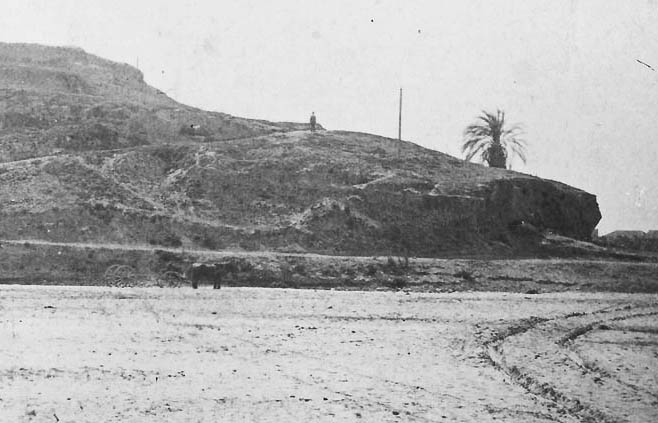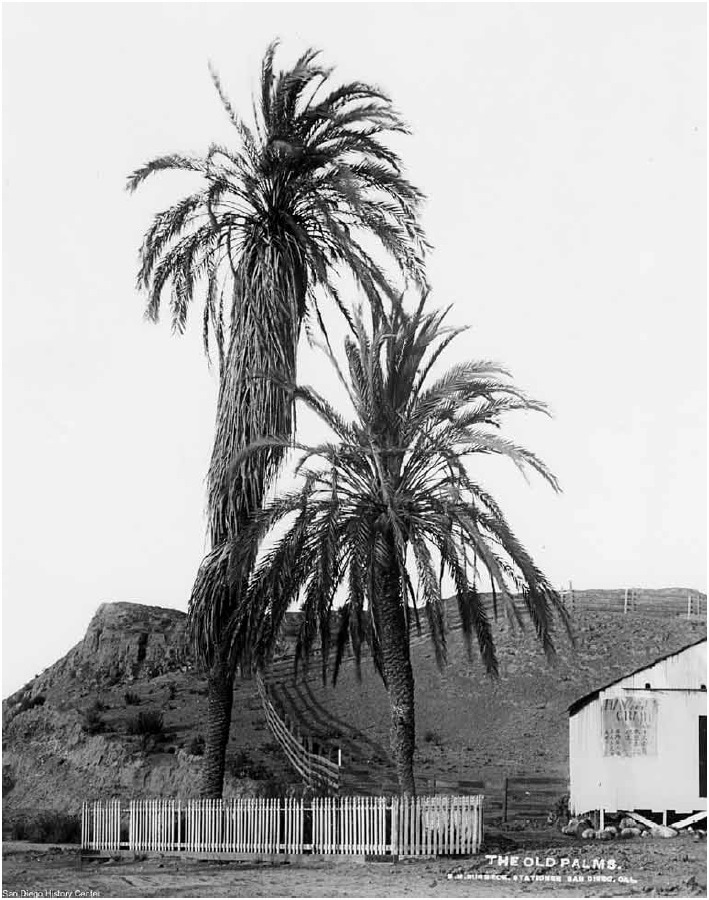The First "Monument" to Presidio Hill The first "monument" to Presidio Hill and its significance were two Canary Island Date Palm trees planted at the foot of the hill in 1769. There is only one Palm species native to California and these palms weren't it, but Palms like this are all over the State now. It is believed these two trees were the first Palms planted in the state by Junipero Serra, himself on July 1, 1769, when the San Diego Missions were first founded. There is no absolute proof of that, but it is what is generally believed. On the hill above the trees, wooden huts and earthworks were set up and a year after Serra's arrival, was reinforced with a wooden stockade, and later with cobble stones and adobe bricks. These bricks were made from earth, straw and mud by natives, who used them to build the church and walls. Each brick had the fingerprints of those who made them or the paw prints of nearby dogs walking over them and by 1773, over four thousand adobe bricks had been made. In 1782, the old church burned down, but was soon rebuilt and by 1796, the Presidio of San Diego officially opened. By 1820, Mexico declared its independence from Spain. Although the Presidio was still in use by the Mexican government, a town was beginning to form at the foot of the hill. As the town formed, the fort become abandoned and would be described as "ruinous" by 1834. There were only about twelve people left living there by that time. Despite that, San Diego would become the Mexican Capitol of California in 1835, despite the presidio becoming abandoned due to the growth of the nearby town. The condition of the Fort didn't improve though and by 1839, the presidio of San Diego was officially disbanded, which caused many of the former Spanish officers to settle just downhill from the presidio. By the time the United States took over San Diego, the Presidio was abandoned except as a cemetery. There were a few adobe walls left, but just about anything of value had been taken. The only other thing left were the Serra Palms, still there after Spanish and Mexican governments had long gone, the trees were now almost ninety years old. With the United States came capitalists and lands were starting to be bought and sold. Just outside the presidio, roads and a dike were dug, altering the original shape of the hill. Aware of the hill's significant past, residents soon saw the need to preserve the two trees as a monument to the Spanish legacy. A wooden fence was transerred from the Serra Cross to keep people from damaging them any further and cables were tied to the trees for support, but the sagging Palms had taken decades of abuse. It had been used as target practice by Spanish soldiers and others had carved their initials on the trunks. Though the trees survived, they both were deteriorating. It was soon realized that even the last standing monument to Spanish colonization was only temporary. A more permanent one would soon be needed. The following are articles from August 1909 editions of the San Diego Tribune which moves the story forward by suggesting a "semi-world's fair" at City Park in honor of the opening of the Panama canal: The San Diego Tribune: 08/26/1909 WHY NOT? Referring to editorials urging a more extensive plan of promotion for San Diego which have appeared in these columns from time to time, George A. Dickens, writing from El Cajon, offers the following suggestion: "Editor Tribune: Referring to the Tribune editorials (dealing with promotion at home and abroad) is it not possible that you, yourself, have furnished the solution of the problem presented? Five years from now steamships will be carrying through freight and passengers from eastern and European ports to Pacific coast points via the Panama canal. What more appropriate than that the first port of entry on the Pacific coast in the United States should be chosen as the place to celebrate the actual opening of this route to permanent traffic? It will be claimed that San Diego cannot accommodate the large attendance of a successful world's fair, but such would not be the case when the time arrives. The site is provided in the 1400-acre park in the heart of the city. There are men of ability here to work out your problem successfully, but the important question is, have these men of ability the nerve to attempt this?" The writer closes with a suggestion that the matter be referred to a gathering of San Diego's most successful and representative business men. A semi-world's fair to celebrate the opening of the Panama canal. Well, why not? San Diego won international fame by the manner in which she received the officers and men of the battleship fleet on its world famous cruise. Why not duplicate that success in celebrating the opening of the great canal project which means so much to this coast and to San Diego? The San Diego Tribune: 08/27/1909 PLAN WORLD'S FAIR FOR CITY OF SAN DIEGO IN 1915 CHAMBER OF COMMERCE IS NOW AT WORK Board of Directors Considering Project for the Holding of Big Celebration on Panama Canal Opening EXPOSITIONS MUCH BENEFIT TO CITIES Proposed to Have Event in Six Years - Secretary Corresponding With Various Commercial Organizations Following an editorial suggestion in the Evening Tribune that San Diego should be the scene of a big celebration to commemorate the opening of the Panama canal, it is announced by Secretary John S. Mills that the San Diego chamber of commerce is now considering such a plan. Secretary Mills, in an interview this morning, stated that the chamber of commerce is now at work on the plan for the holding of a big world's fair in this city in 1915. By that year San Diego will have a bigger population than did Portland when the big exposition was opened in that city. By the year 1915 San Diego, at the present rate of hotel and apartment construction, will have a sufficient number of buildings of the kind to take care of big crowds. That the holding of world's fairs in almost every instance have proved of great benefit to the cities in which they were given, is a well known fact. Following the big world's fair in Chicago, that city advanced with rapid strides. Portland, since the holding of the world's fair, has increased 200,000 in population and is continuing to advance rapidly. Long before the year set for the holding of the exposition to celebrate the opening of the Panama canal, the San Diego & Arizona railroad San Diego will go ahead faster than any city on the Pacific coast and as it is estimated that there are now close to 55,000 people here it is by no means unreasonable to suppose that this number will be as least tripled in the next six years. Chamber at Work Secretary Mills in speaking of the taking up of the work by the chamber of commerce, this morning said: "In Wednesday's Evening Tribune there appeared an editorial containing an excerpt from a letter written by George A Dickens, of El Cajon, in which reference is made to San Diego as a fitting place in which to celebrate the opening of the Panama canal. "This matter is now under consideration by the board of directors of the chamber of commerce. It has not been made public for the good and sufficient reason that there are details to be arranged before announcement can be made. The secretary of the chamber of commerce is corresponding with commercial organizations of other cities where expositions have been successfully held and there are matters of national and state aid to be arranged for. "This matter came up for consideration and the directors were unanimously in favor of the plan. "In reference to the use of our great park for exhibition buildings, it was suggested that the structures might be located and erected with the view of their remaining there permanently. "As an evidence of what these expositions will do for the municipality, let us to the city of Portland. The fair there was not only a financial success, but Portland had at the time it was given a population of not over 100,000. Since then its population has increased to 300,000, or more, as one of the direct results of the enterprise of its citizens. "In 1915, the date now under contemplation for the exposition, San Diego will have a greater population than Portland had when it conceived the idea of its exposition. At the present rate of hotel and apartment house construction it will be possible to take care of all concerns. "Further, San Diego can hold an exposition which can be maintained any month on the year. This in itself will be unique for the chilling winds of autumn and the snow and frost of winter preclude the possibility of an exposition in other cities. "And the chamber of commerce has other plans under consideration for the exposition of the city and county."
0 Comments
Leave a Reply. |
Archives
March 2024
|






 RSS Feed
RSS Feed